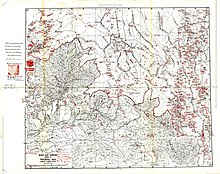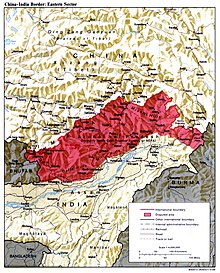মেকমোহন লাইন
মেকমোহন লাইন (ইংৰাজী: McMahan line) ১৯১৪ চনত চিমলা চুক্তিৰ জৰিয়তে বৃটেইন আৰু তিব্বতৰ দ্বাৰা মেকমোহন লাইনক স্বীকৃতি দিয়া হৈছিল।[1] এই ৰেখাটোৱে উত্তৰ-পূব ভাৰত আৰু উত্তৰ বাৰ্মা (ম্যানমাৰ)ৰ সৈতে পূৱ হিমালয় অঞ্চলত দুয়োখন দেশৰ প্ৰভাৱৰ সংশ্লিষ্ট ক্ষেত্ৰবোৰ সীমিত কৰি ৰাখিছিল, যিবোৰ আগতে অনিৰ্ধাৰিত আছিল।[2][3] বৰ্তমান সময়ত এই ৰেখা ভাৰত আৰু চীনৰ মাজত আইনীভাৱে স্বীকৃত সীমান্ত যদিও চীন চৰকাৰে ইয়াক এক বিতৰ্কিত অংশ বুলি গণ্য কৰে।




তথ্যৰ উৎস
সম্পাদনা কৰক- ↑ Lamb, The McMahon Line, Vol. 1 1966, পৃষ্ঠা 4: "The main British gain from the Simla Conference was the delimitation of the McMahon Line, the boundary along the crest of the Assam Himalayas from Bhutan to Burma, by means of an exchange of Anglo-Tibetan notes."
- ↑ Mehra, The McMahon Line and After (1974): Quoting Lord Crew, British Secretary of State for India: "that by a definition of the boundary between Tibet and India he (Crewe) understands the Government of India to mean an agreement as to the spheres, at present undefined, of the two countries in the tribal territory east of Bhutan"
- ↑ Mehra, The McMahon Line and After (1974), p. 225: "there was no intention of 'administering' the country 'within the proposed frontier line much less of undertaking 'military operations' in the area in question. And yet,... it was desirable 'to maintain some semblance of authority that could be backed by force, 'if necessary'."